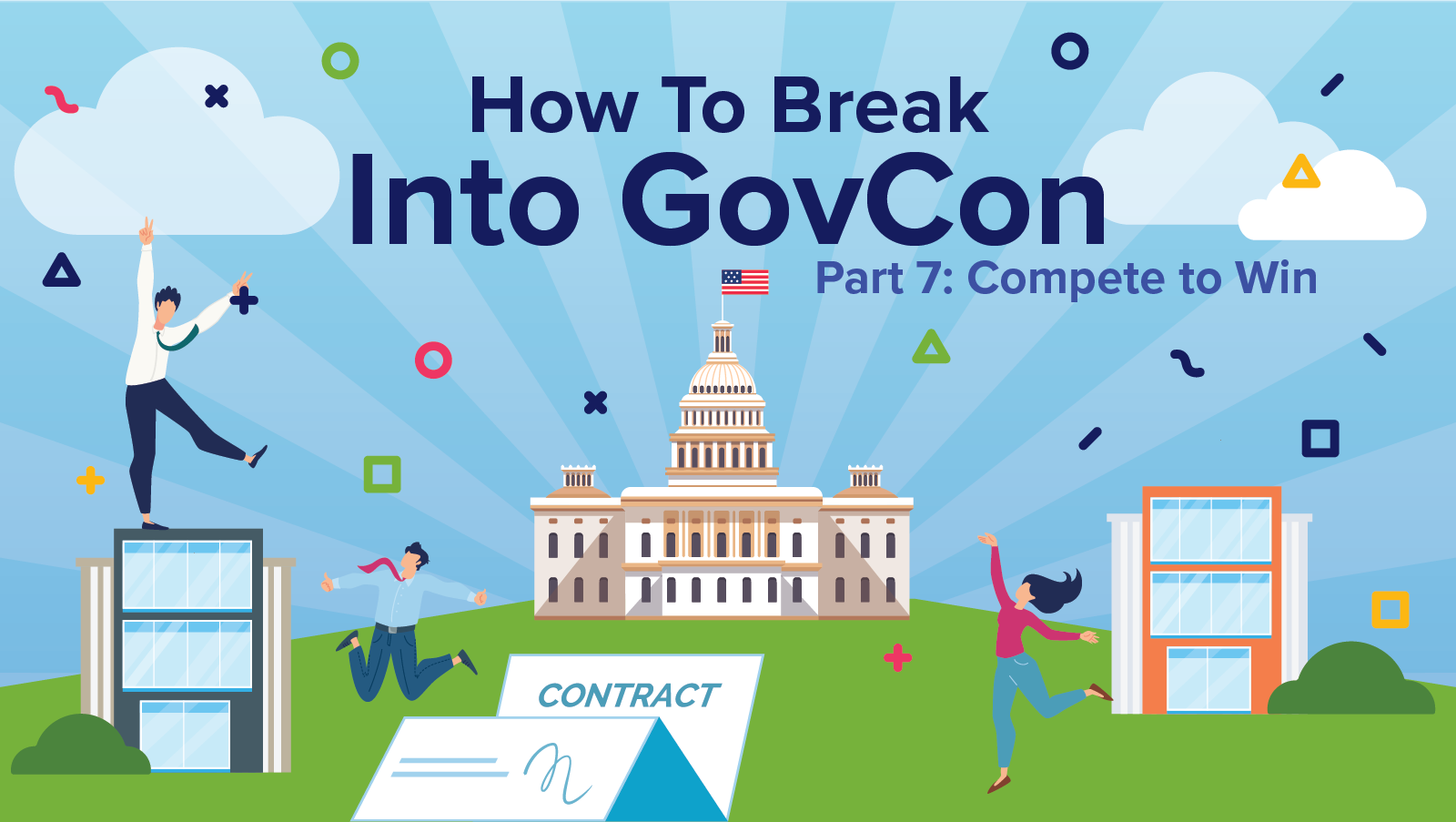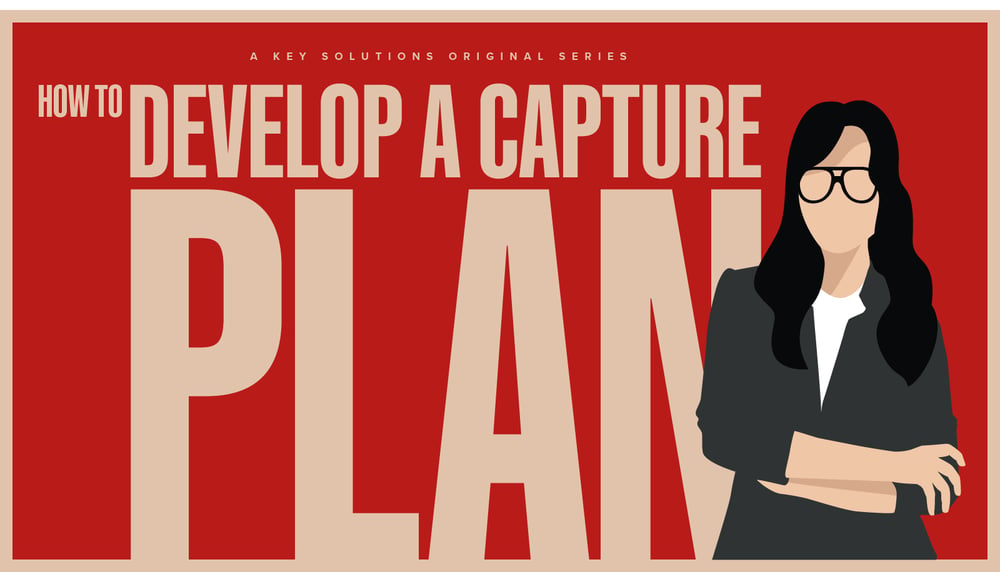
We’ve all experienced a proposal that lacked the appropriate capture before the final RFP release. Various factors can cause this, such as reacting late to an opportunity and not getting in front of a release, lack of customer insight, no understanding of the competition, shortage of time spent on developing a compliant solution, etc. But, when capture is done well, it sets up your team for success and helps avoid the common pitfalls above.
This article focuses on the key elements of capture, how to develop a Capture Plan, and ultimately how to prepare your team for a successful pursuit.
What is a Capture Plan?
A Capture Plan is a document of analysis, strategies, and actions initiated after the pursuit decision. It details customer issues, considerations relating to competitor and internal positioning, and approaches and management tasks to guide the capture of a specific opportunity. Simply put, the Capture Plan is an evolving document used to answer critical questions such as:
- What is the pursuit opportunity?
- Can you win? (Do you have the resources, qualifications, people, etc.?)
- Should you pursue it?
As the bid progresses through the opportunity lifecycle, your team will continue to review the Capture Plan, revising it as needed, by continually asking those same three questions. The information the Capture team continues to gather helps determine if you should bid or no-bid at the gate review milestones. As the Capture Plan evolves and includes more information, your team can use the plan to develop the win strategy and win themes and identify client hot buttons and company discriminators to incorporate into the proposal.
What is the purpose and benefits of using a Capture Plan?
A Capture Plan is an industry best practice used to pursue an opportunity in an organized fashion, while gathering information, details, and intelligence to better position your company or team. The Capture Plan is not only useful to the Capture team, but the Proposal team as well. When developed correctly, the Capture Plan enables a smooth handoff from the Capture team to the Proposal team as an opportunity transitions from the Capture phase to the Pre-RFP and Final RFP phases.
The Capture Plan becomes the source of the proposal’s most salient information, competitive messaging, and win strategy. Using a Capture Plan results in a more effective, efficient, and consistent proposal process for all team members involved.
When is the Capture Plan developed and used?
Understanding the opportunity lifecycle helps you know when to develop, update, and use a Capture Plan. The KSI Advantage™ opportunity lifecycle consists of four main phases:
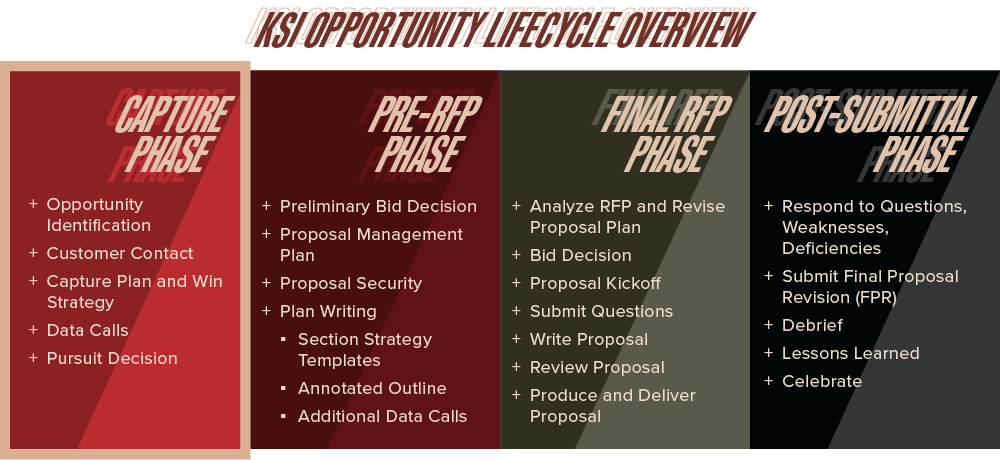
- Capture phase: This is the phase of the opportunity lifecycle consisting of opportunity identification, timely gathering of customer data, win strategy development, and careful resource planning. It establishes a solid foundation for the proposal. The Capture team is responsible for developing, facilitating, leading, and tracking down information and intelligence needed to complete the tasks and deliverables during the Capture phase.
- Pre-RFP phase: This phase of the opportunity lifecycle consists of a preliminary bid decision, development of the proposal management plan, and proposal set-up, security, and preparation. The Capture team supports the sharing and transfer of all information gathered during the Capture phase to the Proposal team, as well as making any necessary updates or changes to the Capture Plan to share with the team.
- Final RFP phase: We move into the Final RFP phase after the release of the final RFP. During this phase, proposal content gets developed and/or revised based on the requirements in the final RFP. The Capture team analyzes the solicitation documents and adjusts the messaging, win strategy, and approach for the opportunity, updating the Capture Plan accordingly. After updating the Capture Plan, the Capture team shifts their focus to ensuring the accuracy of the messaging, strategy, and customer intelligence within the proposal content/writing. The Capture team/Capture Manager works with the Proposal Manager to lead the development of content in the right direction by sharing information with, answering questions from, and providing feedback/guidance to the Proposal team. Color Team Reviews are the Capture team’s opportunity to confirm the direction of the proposal and ensure appropriate information/points get incorporated into each section.
- Post-Submittal phase: The final phase of the opportunity lifecycle is the Post-Submittal phase. After submission, you don’t just pack up your things and call it a day. The Post-Submittal phase is the time to evaluate the entire proposal development process, and identify what went well and what needs improvement. Orals presentations often occur during the Post-Submittal phase, so this is another opportunity for Capture to ensure the presentation reflects the appropriate messaging, strategy, and customer intelligence, while also aligning with the proposal submission. Capture knows the customer and opportunity extremely well so their guidance during the orals preparation process is extremely important.
As shown in the opportunity lifecycle graphic above, the Capture Plan is developed during the Capture phase for use across all phases of the opportunity lifecycle. Updates to the Capture Plan occur periodically during the Pre-RFP and Final RFP phases.
The Capture Plan is important not only to the Capture team, but to the Proposal team as well. The Proposal team uses it during the Pre-RFP phase as writers start developing content for proposal sections. It also becomes a point of reference for weaving strategic messaging into the proposal during the Final RFP phase.
The orals team will use the Capture Plan during the Post-Submittal phase to prepare for an orals presentation to the customer, if required.
The Capture Plan gets updated throughout the Capture, Pre-RFP, and Final RFP phases as you gather more intelligence or as the customer releases more information. The information within the Capture Plan then gets transferred to the Proposal Management Plan, to ensure the Proposal Manager and writers incorporate it into the proposal.
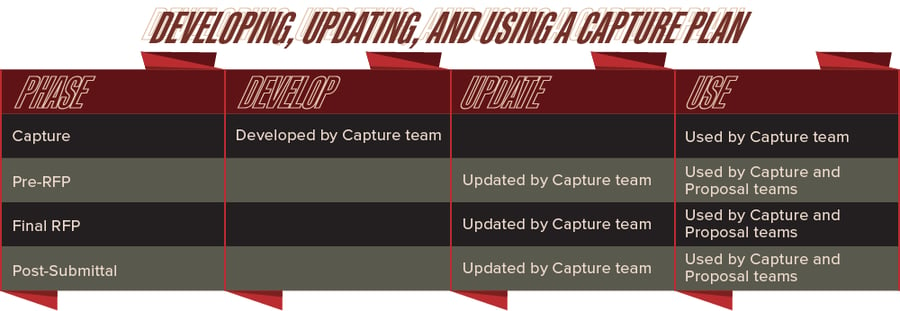
What are the components of a successful Capture Plan?
The table below defines the standard components of a Capture Plan. The gathering of this information enables the Capture team to develop and/or identify the proposal win strategy, win themes, discriminators, and strategic messaging for the bid. Eventually, these components get incorporated into the Proposal Management Plan and receive final approval during the storyboarding process.
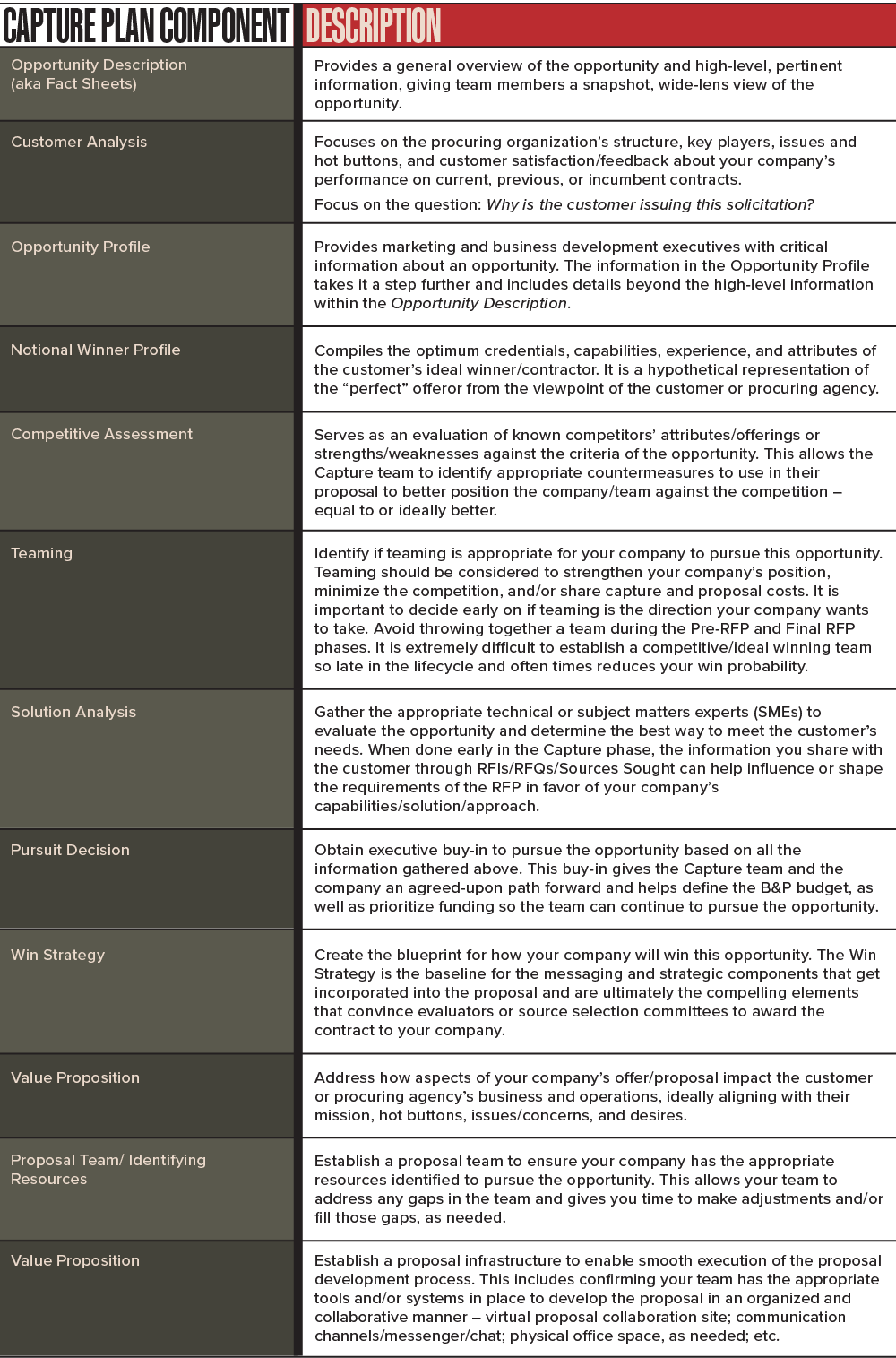
Who is typically involved in the development of a Capture Plan? (roles/responsibilities)
The Capture team composition is scalable to reflect the size and complexity of the opportunity, as well as the available resources or processes of your organization. Below is a list of standard Capture team roles, their responsibilities, and why involving these roles in the Capture Plan development is beneficial.
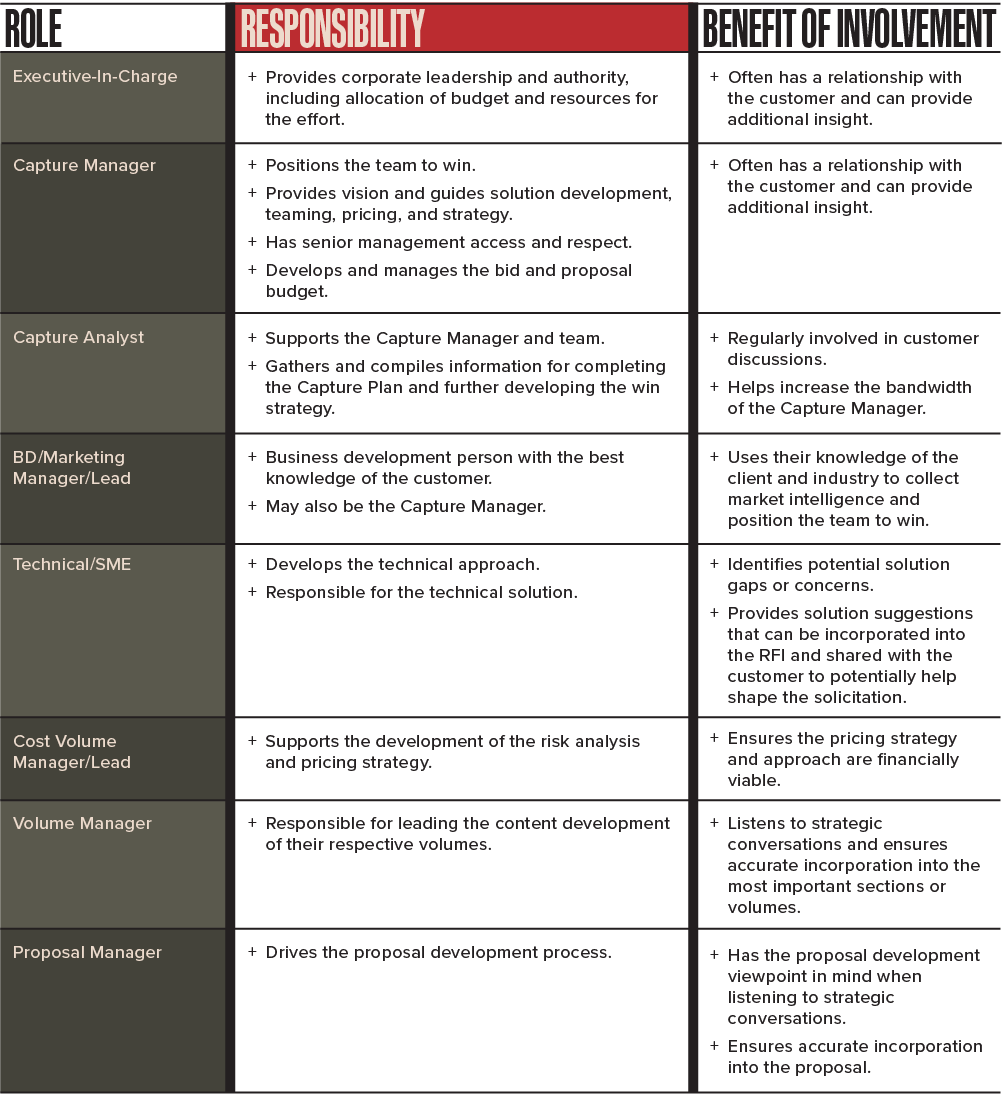
A RACI chart, is a helpful tool that capture team members can use to allocate responsibilities and understand their involvement during the opportunity lifecycle phases.
What are some common pitfalls of developing a Capture Plan? How can you avoid them?
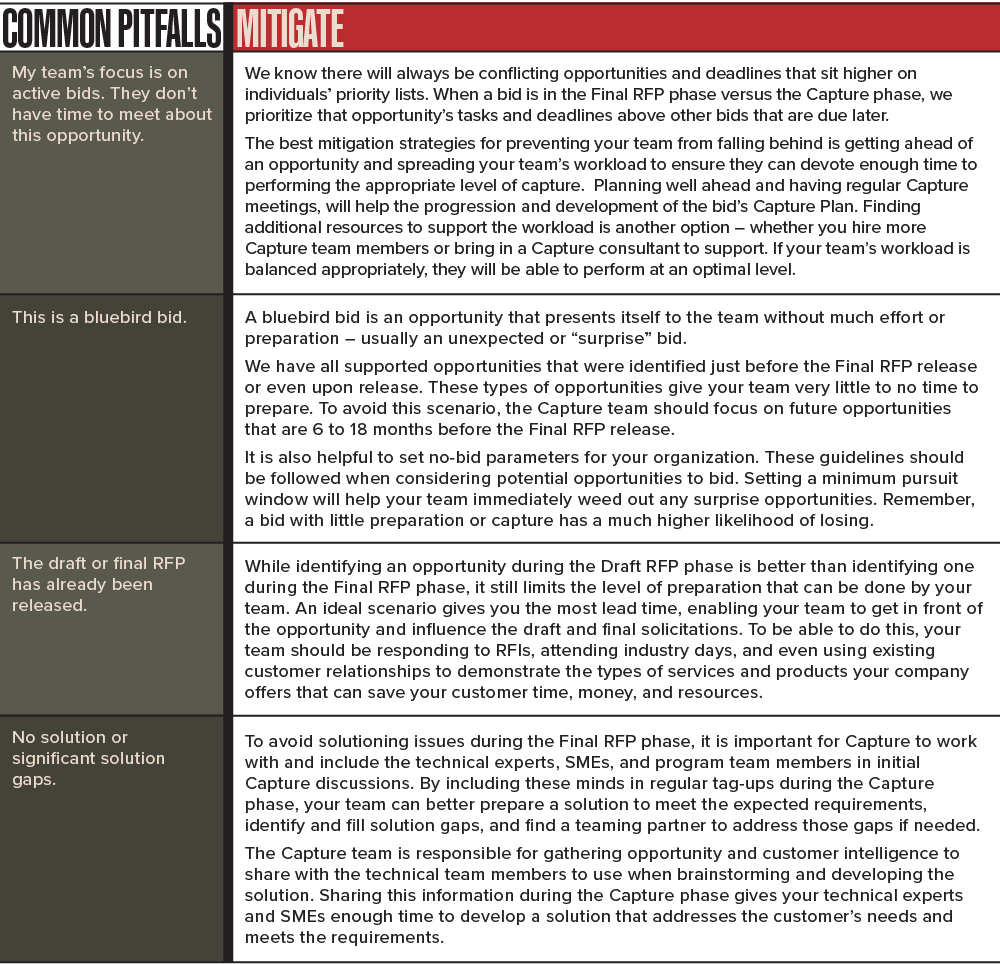
Conclusion
The capture work performed to pursue an opportunity is extremely important for ensuring the success of that submission. The Capture Plan is another tool you can implement into your process to help your team achieve the best possible results. Below is a KSI Capture Plan template with tools from the KSI Advantage™ Capture & Proposal Guide, that you can customize to meet the needs of your team or tailor to your organization’s process.
Additional Resources:



![Download: RACI Chart [Capture Tool]](https://no-cache.hubspot.com/cta/default/2491502/2d7d83be-e117-42ca-a787-9415ea23f39a.png)



